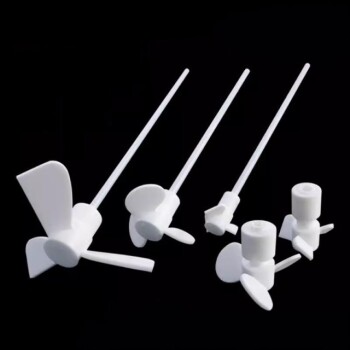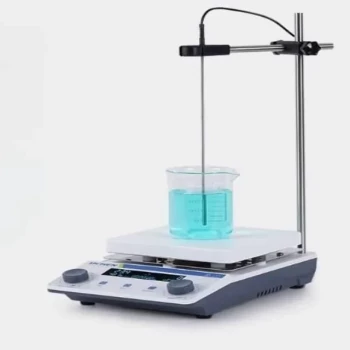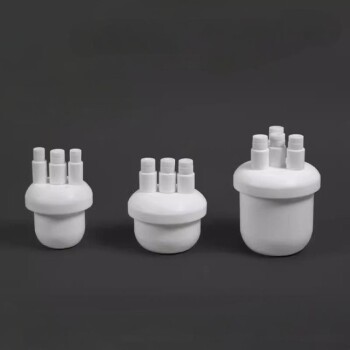Common Issues with Rotary Evaporators
Introduction to Rotary Evaporators
Rotary evaporators stand as one of the most indispensable instruments in chemical laboratories, playing a crucial role in the continuous distillation of volatile solvents under reduced pressure. This sophisticated device is composed of several key components: a motor, a distillation bottle, a heating pot, and a condensation tube, each contributing to its efficient operation.
The core principle of a rotary evaporator lies in its ability to reduce the volume of solvents by distributing them as a thin film across the interior of a vessel. This process, known as rotary evaporation, is conducted at elevated temperatures and under reduced pressure, which significantly accelerates the removal of excess solvent from less volatile samples. This method ensures that solvents are gently and effectively removed from a wide array of samples, including organic, inorganic, and polymeric materials.
The history of rotary evaporators traces back to the 1950s when chemist Lyman C. Craig invented a rudimentary system. This innovation was later commercialized by the Swiss company Büchi in 1957, marking the beginning of a technology that has since become a staple in laboratory settings worldwide.
Role of Spatter Balls
The spatter ball serves as a critical auxiliary glassware component in rotary evaporators, designed to intercept and contain reagents with suspended particulates. By acting as a buffer, it prevents these particulates from directly entering the receiving bottle, thereby maintaining the integrity and purity of the collected distillate. This function is particularly important in experiments where the presence of suspended matter could compromise the results or necessitate additional purification steps. The spatter ball's design allows it to efficiently trap these particles, ensuring smoother and more reliable distillation processes.
Common Problem: Stuck Spatter Ball
The spatter ball frequently becomes lodged due to sample contamination at the interface, rendering it challenging to dislodge. This issue is particularly common when working with reagents containing suspended matter, which can adhere to the spatter ball and the rotary evaporator's interface. The accumulation of these contaminants can create a tight seal, making it difficult to remove the spatter ball without causing damage to the equipment or compromising the integrity of the experiment.
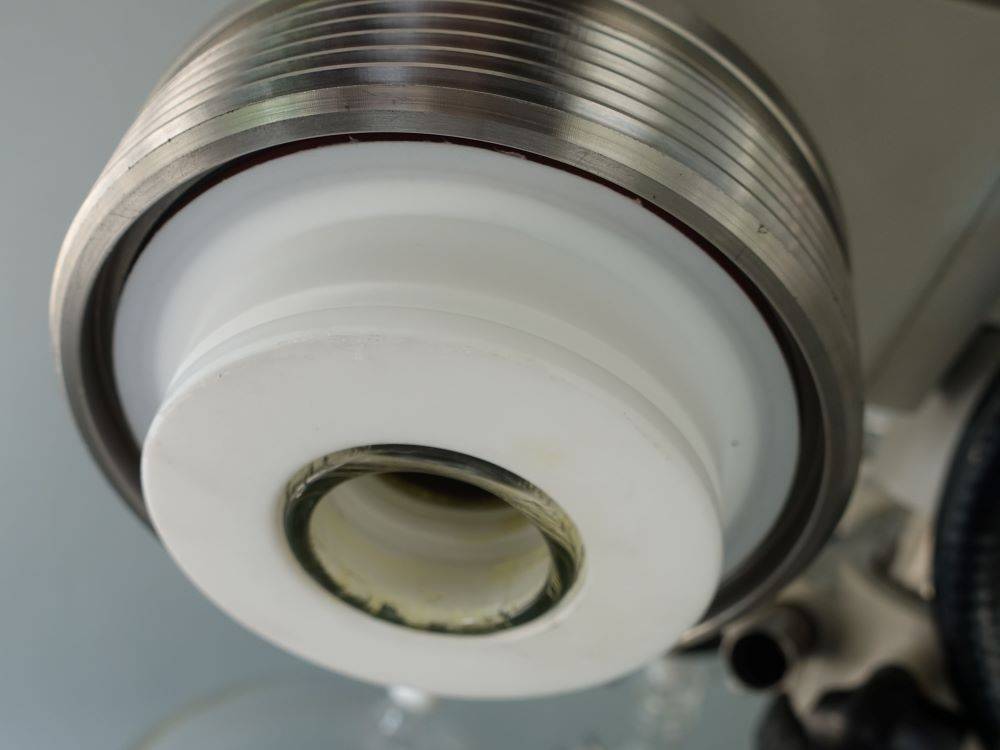
To address this common problem, several methods have been developed, ranging from gentle shaking and knocking to more aggressive techniques like baking, freezing, and even smashing the spatter ball. Each method has its own set of advantages and limitations, and the choice of technique often depends on the severity of the sticking and the specific requirements of the experiment.
| Method | Description | Advantages | Limitations |
|---|---|---|---|
| Shaking | Apply lateral shaking force while wearing canvas gloves. | Non-invasive, minimal risk of damage. | May not work for tightly stuck spatter balls. |
| Knocking | Use a plastic bottle filled with inorganic salts to gently knock the ball. | Simple and effective for loose attachments. | Requires precise control to avoid damage. |
| Baking | Blow hot air evenly over the interface, then knock. | Can soften contaminants for easier removal. | Risk of overheating and damaging the equipment. |
| Freezing | Freeze the spatter ball and shaft, then quickly heat the interface. | Effective for stubborn attachments. | Time-consuming and requires careful temperature control. |
| Smashing | Break the spatter ball if all else fails. | Guaranteed removal, but at the cost of the ball. | Destructive, not suitable for all experiments. |
These methods, while effective, highlight the importance of proper maintenance and careful handling of the rotary evaporator to minimize the risk of spatter ball sticking in the first place.
Solutions to Remove a Stuck Spatter Ball
Shaking Method
If the spatter ball is only slightly stuck, donning canvas gloves can provide a secure grip and protection. Apply a gentle, lateral shaking force to the spatter ball. This method is particularly effective when the adhesion is not particularly strong. The lateral movement helps to dislodge the ball by breaking the surface tension that holds it in place.
To enhance the effectiveness of this method, ensure that the shaking force is applied evenly and steadily. Sudden, jerky movements can sometimes cause the spatter ball to become more firmly lodged. By applying a consistent, lateral force, you can gradually loosen the bond without risking further entrapment.
This technique is often the first step in the removal process due to its simplicity and minimal risk of damage to the equipment. It is particularly useful in laboratory settings where precision and care are paramount. If the shaking method proves insufficient, other techniques such as knocking, baking, or freezing can be employed as outlined in the subsequent sections.
Knocking Method
To effectively dislodge a stuck spatter ball from a rotary evaporator, the knocking method is a practical and widely used technique. This method involves the strategic use of a laboratory plastic bottle filled with inorganic salts. The key to its success lies in the precise application of force. Instead of a direct, forceful impact, a gentle yet consistent knocking motion is employed. This approach minimizes the risk of damage to both the spatter ball and the rotary evaporator while ensuring that the stuck component is gradually loosened.
The process is typically conducted while the rotary evaporator is in operation, specifically during its rotation phase. This synchronized movement aids in the even distribution of the knocking force across the interface where the spatter ball is stuck. The inorganic salts within the plastic bottle serve a dual purpose: they add weight to the bottle, making the knocking more effective, and they also help to absorb any shock, thereby protecting the delicate laboratory equipment.
To execute this method, one must first ensure that the plastic bottle is securely filled with the inorganic salts. The bottle is then carefully positioned so that it can be used to tap the spatter ball without obstructing the rotary motion of the evaporator. A series of gentle, rhythmic taps is applied to the spatter ball, allowing the accumulated forces to gradually work against the adhesion that is holding it in place. This method requires patience and precision, as excessive force could potentially cause damage to the equipment or the spatter ball itself.
In summary, the knocking method is a balanced approach that leverages the rotational dynamics of the rotary evaporator to safely and effectively remove a stuck spatter ball. It combines the use of a weighted, shock-absorbing tool with a controlled application of force, making it a reliable solution in laboratory settings where precision and equipment preservation are paramount.
Baking Method
The baking method involves carefully heating the interface of the spatter ball to loosen its grip. To begin, rotate the spatter ball upwards to expose the interface. Using a hot air gun, evenly distribute the heat across the interface. This step is crucial as it softens any residue or staining that might be causing the spatter ball to stick.
Once the interface has been sufficiently heated, proceed to repeat the knocking steps. This combination of heating and knocking helps to dislodge the spatter ball more effectively. The heat from the hot air gun reduces the adhesion of the residue, making it easier to remove with gentle taps. This method is particularly effective when the spatter ball is stubbornly stuck, as the increased temperature can significantly reduce the force required to detach it.
To ensure safety and effectiveness, it's important to maintain a consistent temperature and avoid overheating, which could damage the glass components. Additionally, using a hot air gun allows for precise control over the heating process, ensuring that only the necessary area is affected. This method is a balance of precision and force, making it a reliable option for those challenging situations where other methods have failed.
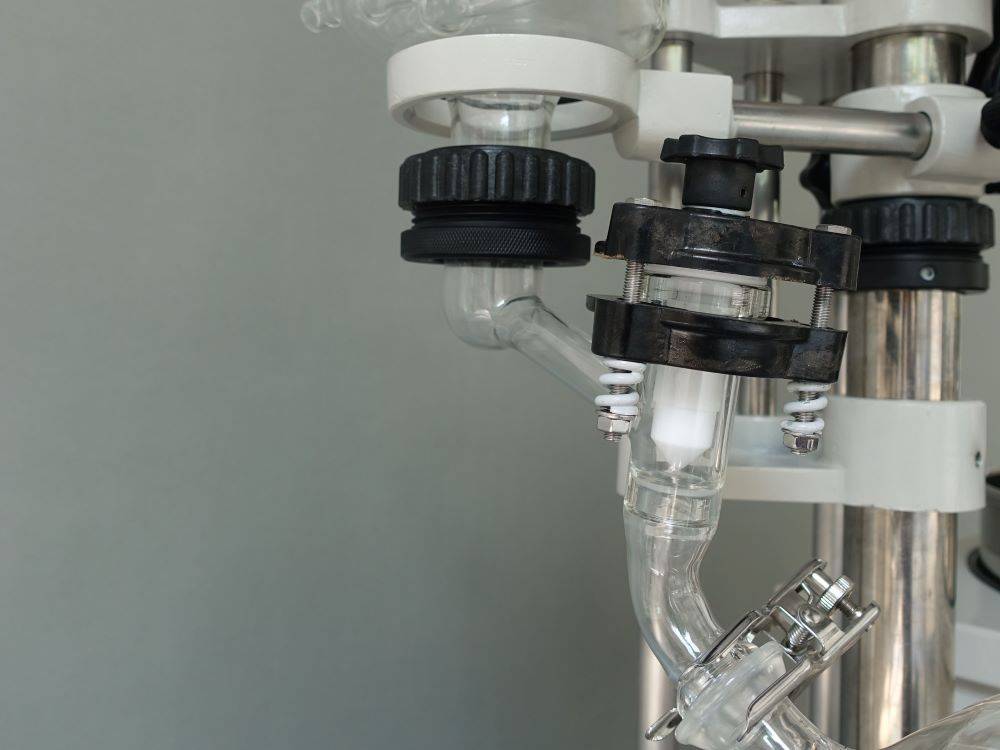
Freezing Method
To effectively remove a stuck spatter ball from a rotary evaporator, the freezing method offers a viable solution. This technique involves submerging both the spatter ball and the glass shaft in a dry ice ethanol bath. The extreme cold from the dry ice causes the components to contract, potentially loosening the bond between the spatter ball and the glass shaft.
Once the spatter ball and glass shaft have been sufficiently chilled, the next step is to quickly transition to heat. This is achieved by using a hot air gun to evenly bake the interface where the spatter ball is attached. The rapid change from extreme cold to heat can create a thermal shock, further aiding in the dislodging of the spatter ball.
| Step | Action | Purpose |
|---|---|---|
| 1 | Submerge in dry ice ethanol bath | Contract components to loosen bond |
| 2 | Quickly bake interface with hot air gun | Create thermal shock to aid dislodging |
This method leverages the principles of thermal expansion and contraction, making it a practical approach for those who encounter frequent issues with stuck spatter balls in their laboratory work.
Smashing Method
When all other methods have been exhausted and the spatter ball remains stubbornly stuck, the final recourse is to consider smashing it. This drastic measure should only be taken after careful evaluation and when no other options are viable. The process involves carefully breaking the spatter ball at the interface where it is stuck, allowing for its removal. This method is particularly useful when dealing with extremely hard-to-remove samples that have deeply stained the interface.
However, it's crucial to note that smashing the spatter ball is a last resort due to the potential damage it can cause to the rotary evaporator. This method should be approached with caution, ensuring that protective measures are in place to prevent injury and to minimize damage to the equipment. Additionally, it is recommended to have a replacement spatter ball ready to install immediately after the old one is removed, ensuring the continuity of the experiment without significant downtime.
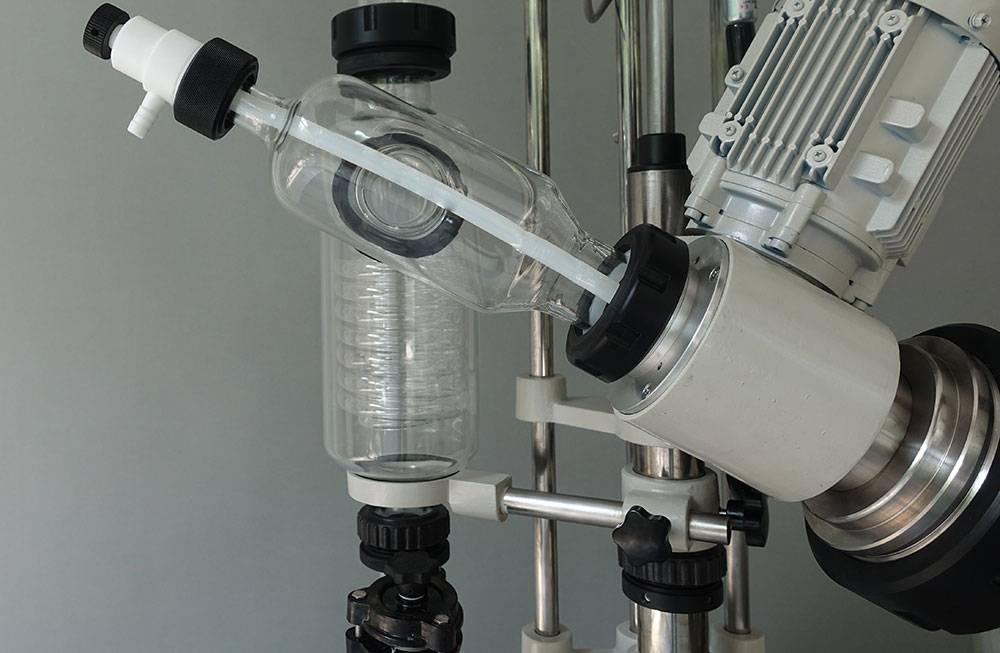
Additional Suggestions from Partners
Rotating Steam Method
The rotating steam method is an innovative technique designed to dislodge a stuck spatter ball from a rotary evaporator. This method leverages the power of steam to create rotational forces that can effectively free the spatter ball from its stubborn position. Here’s how it works:
-
Steam Generation: Begin by generating a steady stream of steam. This can be achieved using a laboratory steam generator or by boiling water in a controlled environment.
-
Steam Application: Direct the steam towards the junction where the spatter ball is stuck. The steam should be applied in a way that it creates a rotating motion around the glass axis.
-
Fixing the Plastic Ring: As the steam circulates, it exerts pressure on the plastic ring attached to the glass axis. This pressure helps to fix the plastic ring in place, ensuring that the rotational force is concentrated on the spatter ball.
-
Squeezing the Spatter Ball: The continuous rotation of the steam causes a squeezing effect on the spatter ball. This squeezing motion works to loosen the adhesion between the spatter ball and the glass axis, eventually freeing it from its stuck position.
This method is particularly effective when other techniques, such as shaking or knocking, have failed. The use of steam not only provides a controlled force but also ensures that the process is carried out in a manner that minimizes damage to the rotary evaporator.
Ultrasonic Oscillation Method
The Ultrasonic Oscillation Method offers a sophisticated approach to dislodging a stuck spatter ball from a rotary evaporator. This technique leverages the power of ultrasonic waves to create microscopic vibrations that can effectively break the adhesion between the spatter ball and the glass interface. By immersing the affected area in an ultrasonic bath, the high-frequency vibrations can penetrate the surface, loosening the bond without causing damage to the delicate glass components.
Ultrasonic oscillation is particularly effective when other methods, such as shaking or knocking, have proven insufficient. The process involves placing the rotary evaporator's component into an ultrasonic cleaner, which is typically filled with a suitable cleaning solution. The ultrasonic waves generate cavitation bubbles that implode on the surface of the spatter ball, providing a gentle yet powerful force that can dislodge even the most stubborn stains or residues.
This method is not only efficient but also minimizes the risk of breakage or damage to the equipment, making it a preferred choice for laboratories where precision and safety are paramount. The ultrasonic bath can be adjusted to different frequencies and amplitudes, allowing for customization based on the specific nature of the adhesion and the material properties of the spatter ball.
In summary, the Ultrasonic Oscillation Method provides a non-invasive and highly effective solution for removing a stuck spatter ball, ensuring that the rotary evaporator can be restored to optimal functioning without compromising the integrity of its components.
Bottle Withdrawer Method
When dealing with a stubbornly stuck spatter ball, the bottle withdrawer method offers a reliable solution. This tool, specifically designed for delicate glassware manipulation, provides a controlled and precise means to extract the spatter ball without causing damage to the rotary evaporator's components. The bottle withdrawer's ergonomic design ensures that even those with limited manual dexterity can effectively use it to coax the spatter ball free.
To employ this method, first, ensure that the bottle withdrawer is securely attached to the spatter ball. This step is crucial to avoid any accidental slips or breaks. Once the withdrawer is in place, apply gentle but steady pressure to gradually pull the spatter ball out of its stuck position. The key here is to maintain a consistent force, avoiding sudden jerks that could potentially harm the delicate glass interface.
In situations where the spatter ball is deeply embedded, it might be necessary to combine the bottle withdrawer method with other techniques such as gentle heating or freezing. For instance, a brief application of a hot air gun to the interface can soften any adhesive residues, making the spatter ball easier to withdraw. Conversely, freezing the area with a dry ice ethanol bath can contract the material, creating a slight gap that facilitates removal.
It's important to note that while the bottle withdrawer method is effective, it should be used as part of a comprehensive strategy. Combining it with other methods ensures a higher success rate and minimizes the risk of damage to the equipment. This holistic approach not only aids in the current removal process but also prepares for potential future occurrences, ensuring smoother operation of the rotary evaporator.
Application to Other Glass Interfaces
General Applicability
The techniques and strategies outlined in this article for removing a stuck spatter ball from a rotary evaporator are not confined to this specific application. These methods can be effectively adapted to address a variety of other glassware interfacing issues commonly encountered in laboratory environments. Whether it's a stuck condenser tube, a jammed distillation bottle, or any other glass component that has become adhered due to chemical reactions or physical obstructions, the principles remain the same.
For instance, the shaking method can be employed to gently dislodge any glassware that is only partially stuck. Similarly, the knocking method using a weighted bottle filled with inorganic salts can be replicated to apply controlled force to the problem area. The baking method and freezing method can also be used in conjunction to create a thermal shock effect, which can be particularly effective for breaking the bond between glass components.
In more severe cases, where traditional methods fail, the smashing method can be considered as a last resort, albeit with caution to prevent damage to the surrounding equipment. Additionally, innovative techniques such as the rotating steam method, ultrasonic oscillation method, and bottle withdrawer method can be tailored to suit different types of glass interfaces, offering a versatile toolkit for laboratory technicians to resolve a wide array of stuck glassware issues.
Related Products
- Custom PTFE Teflon Parts Manufacturer Adjustable Height Flower Basket
- Custom PTFE Teflon Parts Manufacturer for Magnetic Stirring Bar
- Custom PTFE Teflon Parts Manufacturer Laboratory High Temperature Mixing Paddle Mixer
- Laboratory Small Constant Temperature Heated Magnetic Stirrer Heater and Stirrer
- Custom PTFE Teflon Parts Manufacturer for Three-Necked Round Bottom Flask



